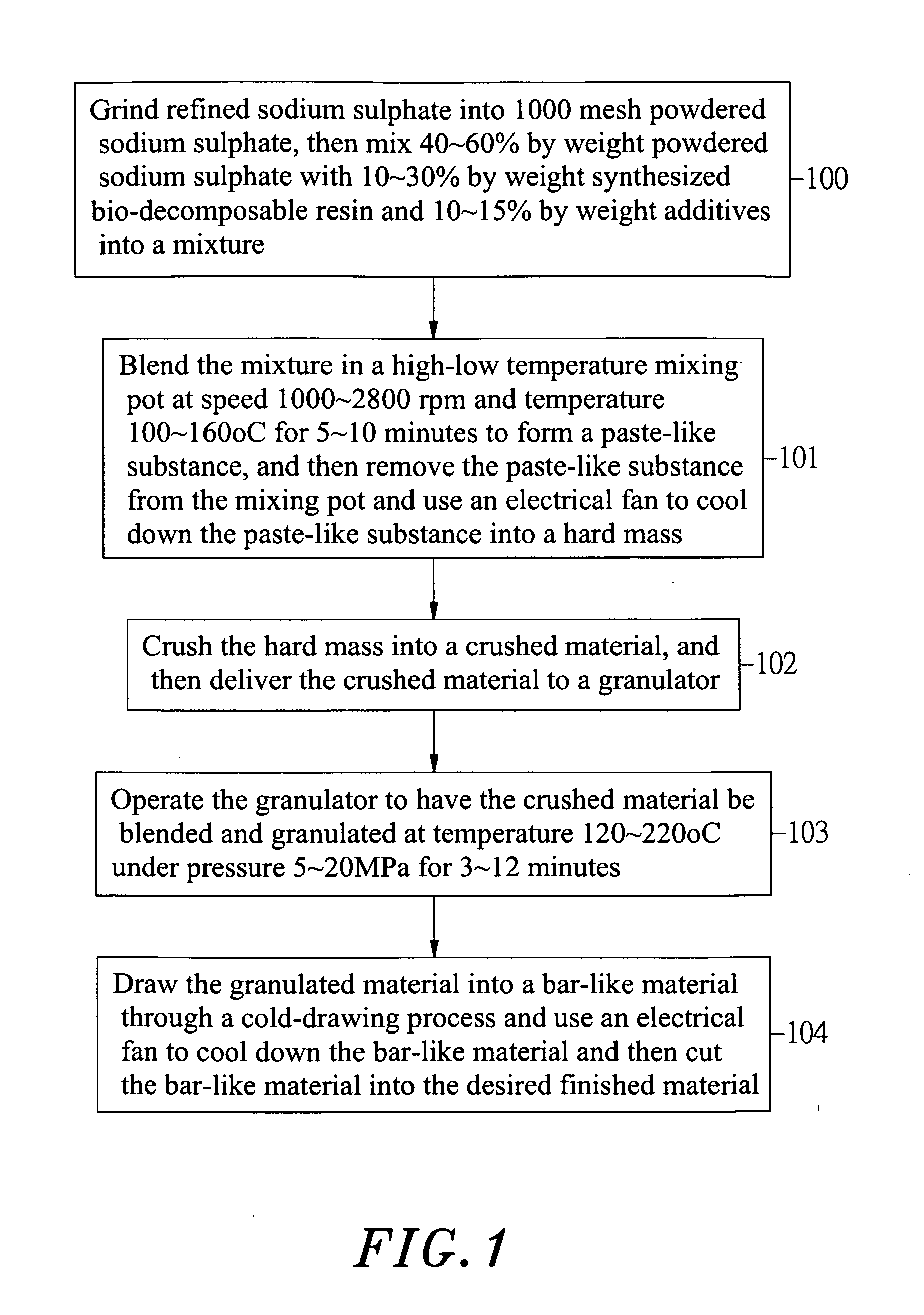Additive type bio-decomposable composite preparation method
a bio-decomposable and composite technology, applied in the field of bio-decomposable composite preparation methods, can solve the problems of not being able to meet the requirements of the product, etc., to save the cost of plastic materials, improve the product's temperature resistance property, and reduce the fogging extent of the product
- Summary
- Abstract
- Description
- Claims
- Application Information
AI Technical Summary
Benefits of technology
Problems solved by technology
Method used
Image
Examples
example i
[0024]60 Kgs sodium sulfate (about 1000 mesh powdered status) was mixed with 15 Kgs polycaprolactone (PCL), 10 Kgs polybutylene succinate (PBS), 7 Kgs glycerin (affinant), 3 Kgs organic silanes (coupling agent) and 5 Kgs additive in a high-low temperature mixing pot at a mixing speed about 1400 rpm and a mixing temperature about 80° C. for about 10 minutes to form a white, uniform mixture, and then the white, uniform mixture was put in a hopper and guided into a double-screw extruding machine and processed under a processing temperature about 120˜200° C. and a processing pressure about 10˜15 MPa for about 5 minutes. After blending, granulation and cooling steps, a white, uniform, grained product of grain size about 2 mm was obtained. When the bio-decomposable composite becomes a waste product, it will be decomposed gradually under a variety of natural environmental conditions and return to nature.
example ii
[0025]50 Kgs sodium sulfate (about 1000 mesh powdered status) was mixed with 30 Kgs polybutylene succinate (PBS), 8 Kgs glycerin (affinant), 2 Kgs butyl phthalate (coupling agent) and 10 Kgs additive in a high-low temperature mixing pot at a mixing speed about 1400 rpm and a mixing temperature about 100° C. for about 10 minutes to form a white, uniform mixture, and then the white, uniform mixture was put in a hopper and guided into a double-screw extruding machine and processed under a processing temperature about 120˜185° C. and a processing pressure about 5˜15 MPa for about 5 minutes. After blending, granulation and cooling steps, a white, uniform, grained product of grain size about 2 mm was obtained. When the bio-decomposable composite becomes a waste product, it will be decomposed gradually under a variety of natural environmental conditions and return to nature.
example iii
[0026]70 Kgs sodium sulfate (about 1000 mesh powdered status) was mixed with 10 Kgs polybutylene succinate (PBS), 8 Kgs glycerin (affinant), 5 Kgs butyl phthalate (coupling agent) and 7 Kgs additive in a high-low temperature mixing pot at a mixing speed about 1400 rpm and a mixing temperature about 100° C. for about 10 minutes to form a white, uniform mixture, and then the white, uniform mixture was put in a hopper and guided into a double-screw extruding machine and processed under a processing temperature about 120˜200° C. and a processing pressure about 10˜15 MPa for about 5 minutes. After blending, granulation and cooling steps, a white, uniform, grained product of grain size about 2 mm was obtained. When the bio-decomposable composite becomes a waste product, it will decompose gradually under a variety of natural environmental conditions and return to nature.
[0027]An additive type bio-decomposable composite prepared according to either of the aforesaid various examples of the p...
PUM
| Property | Measurement | Unit |
|---|---|---|
| temperature | aaaaa | aaaaa |
| pressure | aaaaa | aaaaa |
| temperature | aaaaa | aaaaa |
Abstract
Description
Claims
Application Information
 Login to View More
Login to View More - R&D
- Intellectual Property
- Life Sciences
- Materials
- Tech Scout
- Unparalleled Data Quality
- Higher Quality Content
- 60% Fewer Hallucinations
Browse by: Latest US Patents, China's latest patents, Technical Efficacy Thesaurus, Application Domain, Technology Topic, Popular Technical Reports.
© 2025 PatSnap. All rights reserved.Legal|Privacy policy|Modern Slavery Act Transparency Statement|Sitemap|About US| Contact US: help@patsnap.com

